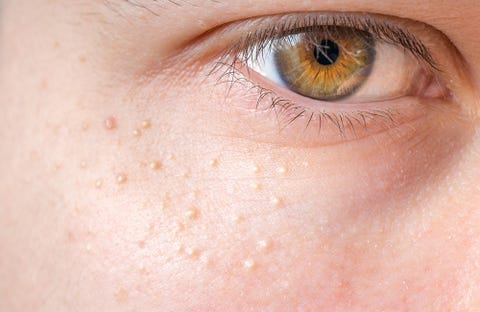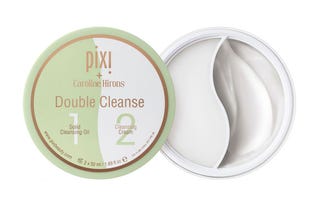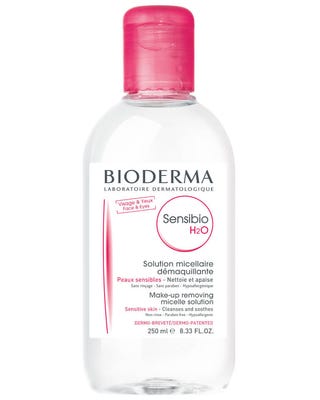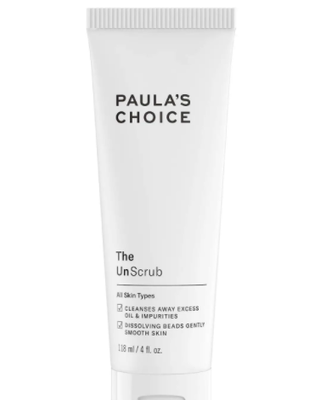How to Get Rid of Milia Under Eyes
If, when peering close into a magnifying mirror, you've noticed a smattering of tiny, milky-white spots lying beneath the surface of your skin, you're not alone. They're known as milia, and are purely a cosmetic issue with no health concerns attached. However, there are ways to get rid of them, should you want to.
Here, see everything you need to know about milia, from how and why they form, to the safest ways to say goodbye to yours...
What are milia?
Often mistaken for whiteheads, milia are actually keratin-filled cysts that form just under the skin, looking like white or yellowish bumps on the surface. Nicknamed 'milk spots', milia is a condition commonly associated with newborn babies, but occurs in children and adults, too.
To better practice prevention and cure, we spoke to four skincare specialists – a leading London dermatologist, Dr Sam Bunting, respected facialists Aleksandra Encheva and Michaella Bolder, and cosmetic acupuncture pioneer Dr (TCM) John Tsagaris – who shared the dos and don'ts of milia treatment.
Milia causes
"There are several factors that cause milia in adults," Encheva explains. "Most commonly, they occur due to dead skin building up and getting trapped in the pores near the surface of the skin. If the build-up doesn't get expelled naturally, it can become a small cyst." This type is called primary milia.
When it comes to the eye area specifically, Dr Tsagaris explains that when skincare doesn't penetrate properly, primary milia can manifest. "Unlike skin on the rest of the face, the eye area does not contain oil glands that can help keep this skin moist and it has limited blood circulation – therefore eye creams need to be very specialised so they can increase skin volume and firmness as well as being able to be absorbed properly," he explains.
The other type, secondary milia, looks similar to primary milia but develops very differently. Encheva explains: "Secondary milia happens when something clogs the sweat ducts. This is usually caused by some kind of skin trauma or infection, (such as laser treatments, chemical peels, and herpes), or contributing lifestyle factors, including lack of sleep, smoking, poor personal hygiene, using oil-based beauty products in excess, and long-term steroid use".
Both types can be treated in the same way, but before considering treatment for milia, it's worth noting that they may simply disappear on their own. Bolder says, "Depending how deep the milia lay, they can naturally come to the surface of the skin after a few weeks or months". The experts feel that if milia doesn't bother you, it's best to leave well alone. However there are quick and easy professional treatments should you want to see the back of them.

Getty Images
How to get rid of milia: your treatment options
First up, forget squeezing. "This will only irritate and cause damage to the skin without being able to remove the problem," Bolder warns. Encheva agrees: "squeezing the bump with your bare hands is a big no-no" – as is taking any tools to the milia. "You don't want to damage your skin with poor removal techniques," she adds.
Your best bet is the pro route. "Milia removal with a skincare professional usually requires an incision, especially when the cysts are deep below the skin's surface," Encheva explains. "Typically, it's a quick and painless procedure. Depending on the dermatologist or aesthetician, they should be able to get rid of the milia using a comedone extractor, lancing tool or needle."
Bolder breaks down the latter technique: "With a sterile needle you can gently flick up the outer most surface of skin freeing the milia and enabling you to wiggle it out like a tiny chalk ball." Sounds weirdly satisfying.
How to prevent milia
As ever with skincare, prevention is better than cure (there's no needles involved, for one), so try these suggestions if milia is a recurring concern for you:
1. Thorough cleansing

Courtesy
"Removing your make-up thoroughly before bed is vital," Encheva instructs. If you're not already, try double-cleansing in the evenings, particularly if you wear heavy make-up and/or live in a polluted area. The first cleanse removes your make-up, SPF and sebum (use something like an oil cleanser to melt make-up), and the second – which is where facial massage can come into play – should remove any further impurities and treat the skin. Try: Pixi Double Cleanse, one product housing a solid cleansing oil and a luxe cleansing cream.
2. Avoid oily eye make-up removers and rich eye creams
However, heed Dr Bunting's advice and avoid oil-based formulas around the eyes, because "oily or biphasic eye make-up removers can leave an oily residue in the this area," she explains. Try: a micellar water instead, such as the Bioderma Sensibio H2O Make-up Removing Micelle Solution which easily removed eye make-up.
When loaded onto the thin skin with limited blood circulation, rich eye creams also prevent a recipe for clogging. Therefore, Dr Tsagaris says it's vital to use specialised eye creams instead of taking your face moisturiser close to the eye area. Try: a lightweight, serum-textured eye treatment such as the Medik8 r-Retinoate Day & Night Eye Serum, which will absorb quickly into the skin without forming a film on the surface.

r-Retinoate Day & Night Eye Serum
This lightweight retinol eye serum will encourage cell turnover, helping prevent milia around in that area.

Sensibio H2O Make-Up Removing Solution Sensitive Skin
Bioderma lookfantastic.com
£10.80
This classic make-up remover has been relied upon by industry experts for years.

Skin Perfecting 2% BHA Liquid Exfoliant
Paula Begoun's salicylic-acid based toner is ideal for exfoliating without irritation.

The UnScrub
This gently cleanses and polishes skin with dissolvable jojoba beads, making over-scrubbing impossible.
3. Incorporate exfoliation
"The most effective way to keep milia at bay is to encourage skin cell turn over," explains Bolder. "Helping to do so will prevent natural build up of dead cells that linger on the surface resulting in congestion and milia". When it comes to skin on the face in general, this can be done with exfoliation, performed using a mechanical scrub and/or a chemical exfoliating acid. "A mechanical exfoliant is great to help buff the surface layer once a week, while a chemical exfoliant twice a week will work to break the bonds of dead skin cells that linger on the surface causing congestion and milia." Try: Paula's Choice The UnScrub and Paula's Choice Resist Anti-Aging 2% BHA Exfoliant, making sure to always use broad-spectrum sunscreen during the day.
However, exfoliation around the eye area isn't recommended: "The skin tissue is much thinner and more sensitive, therefore overstimulating the eye area can cause soreness and sensitivity." Instead she suggests using an eye cream with active ingredients (such as retinol) that works in a similar way (see below).
4. Try retinol
"Retinol is also very helpful for both fighting and preventing milia," explains Encheva. Bolder echoes this, explaining that the form of vitamin A "assists skin cell turn over, allowing the milia to surface" – and preventing the build-up of dead cells leading to the cysts in the first place. However, "make sure to avoid applying retinol to the eyelids," Encheva warns. Try: Dr Sam's Flawless Nightly Serum for the face and, as above, Medik8 r-Retinoate Day & Night Eye Serum for the eye area. The latter can be used day and night to tighten and brighten thanks to a non-irritating derivative of vitamin A that can be used on even the most sensitive eyes.
5. Lifestyle choices
Finally, consider adopting lifestyle changes that can help prevent milia. "Limiting your intake of cholesterol-rich foods (such as meat and eggs), incorporating vitamin D supplements, avoiding heavy oil-based make-up products and limiting sun exposure could all help in preventing milia," explains Encheva.
This content is created and maintained by a third party, and imported onto this page to help users provide their email addresses. You may be able to find more information about this and similar content at piano.io
How to Get Rid of Milia Under Eyes
Source: https://www.harpersbazaar.com/uk/beauty/skincare/a18542004/milia-causes-and-treatments/